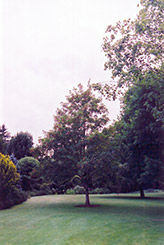Erythrocarpum Sycamore Maple
Acer pseudoplatanus 'Erythrocarpum'
Height: 60 feet
Spread: 50 feet
Sunlight:
![]()
Hardiness Zone: 4
Other Names: Planetree Maple
Description:
An uncommon maple from Europe with a broad habit of growth and large lobed leaves; bright red fruits are particularly showy in fall, add an interesting dimension to this choice shade tree
Ornamental Features
Erythrocarpum Sycamore Maple is primarily grown for its highly ornamental fruit. It features abundant showy red samaras from early to mid fall. It has dark green deciduous foliage. The lobed leaves turn an outstanding brown in the fall.
Landscape Attributes
Erythrocarpum Sycamore Maple is a deciduous tree with a shapely oval form. Its average texture blends into the landscape, but can be balanced by one or two finer or coarser trees or shrubs for an effective composition.
This tree will require occasional maintenance and upkeep, and should only be pruned in summer after the leaves have fully developed, as it may 'bleed' sap if pruned in late winter or early spring. It has no significant negative characteristics.
Erythrocarpum Sycamore Maple is recommended for the following landscape applications;
- Accent
- Shade
Planting & Growing
Erythrocarpum Sycamore Maple will grow to be about 60 feet tall at maturity, with a spread of 50 feet. It has a high canopy of foliage that sits well above the ground, and should not be planted underneath power lines. As it matures, the lower branches of this tree can be strategically removed to create a high enough canopy to support unobstructed human traffic underneath. It grows at a medium rate, and under ideal conditions can be expected to live for 80 years or more.
This tree should only be grown in full sunlight. It prefers to grow in average to moist conditions, and shouldn't be allowed to dry out. It is not particular as to soil type or pH, and is able to handle environmental salt. It is highly tolerant of urban pollution and will even thrive in inner city environments. This is a selected variety of a species not originally from North America.
